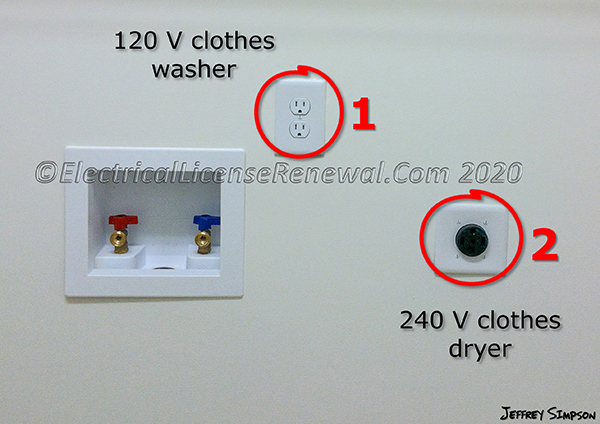210.8(A) GFCI Protection. Dwelling Units.

Code Change Summary: New requirements added to existing code language. For dwellings, the 2020 NEC® will expand GFCI requirements to include receptacles up to 250V in specific locations.
Each code change cycle more and more movement towards whole house GFCI protection occurs. The 2020 NEC® is no different. In the past, GFCI protection in dwellings was required for 125-volt, single-phase, 15- and 20- ampere receptacles in specific locations. This cycle removes “15- and 20- ampere” from the text and expands GFCI protection in dwellings to include receptacles up to 250 volts such as the typical range or dryer receptacle, but only if these receptacles are placed in specific locations.
For example, most dwelling unit kitchens have a cord and plug connected, 240-volt oven/range but the receptacle for it is not installed to serve the countertop (see item 6 below), therefore it would not require GFCI protection unless the receptacle is installed within 6 feet from the top inside edge of the kitchen sink bowl (see item 7 below).
Another big change in this section is item 5 in the code language below. In the past, GFCI protection was required for specific receptacles in “unfinished portions or areas of the basement not intended as habitable rooms”. Now, item 5 below simply applies to “basements” whether they are finished or unfinished.
The code committee statement regarding the change to GFCI protection in the basement expressed that there are potential electrical hazards in basements which are not eliminated just because a basement is finished or unfinished. A moisture hazard may exist with a person coming in contact with a damp floor, regardless of flooring type, and then interacting with the electrical system.
Applying the revised code language in this section will also mean that most 240V residential clothes dryer receptacles will require GFCI protection.
Below is a preview of the NEC®. See the actual NEC® text at NFPA.ORG for the complete code section. Once there, click on their link to free access to the 2020 NEC® edition of NFPA 70.
2017 Code Language:
210.8(A) Dwelling Units. All 125-volt, single-phase, 15- and 20- ampere receptacles installed in the locations specified in 210.8(A)(1) through (10) shall have ground-fault circuit interrupter protection for personnel.
(1) Bathrooms
(2) Garages, and also accessory buildings that have a floor located at or below grade level not intended as habitable rooms and limited to storage areas, work areas, and areas of similar use
(3) Outdoors
Exception to (3): Receptacles that are not readily accessible and are supplied by a branch circuit dedicated to electric snow-melting, deicing, or pipeline and vessel heating equipment shall be permitted to be installed in accordance with 426.28 or 427.22, as applicable.
(4) Crawl spaces — at or below grade level
(5) Unfinished portions or areas of the basement not intended as habitable rooms
Exception to (5): A receptacle supplying only a permanently installed fire alarm or burglar alarm system shall not be required to have ground-fault circuit-interrupter protection.
Informational Note: See 760.41(B) and 760.121(B) for power supply requirements for fire alarm systems.
Receptacles installed under the exception to 210.8(A)(5) shall not be considered as meeting the requirements of 210.52(G).
(6) Kitchens — where the receptacles are installed to serve the countertop surfaces
(7) Sinks — where receptacles are installed within 1.8 m (6 ft) from the top inside edge of the bowl of the sink
(8) Boathouses
(9) Bathtubs or shower stalls — where receptacles are installed within 1.8 m (6 ft) of the outside edge of the bathtub or shower stall
(10) Laundry areas
2020 Code Language:
210.8(A) Dwelling Units. All 125-volt through 250-volt receptacles installed in the locations specified in 210.8(A)(1) through (A)(11) and supplied by single-phase branch circuits rated 150 volts or less to ground shall have ground-fault circuit-interrupter protection for personnel.
(1) Bathrooms
(2) Garages and also accessory buildings that have a floor located at or below grade level not intended as habitable rooms and limited to storage areas, work areas, and areas of similar use
(3) Outdoors
Exception to (3): Receptacles that are not readily accessible and are supplied by a branch circuit dedicated to electric snow-melting, deicing, or pipeline and vessel heating equipment shall be permitted to be installed in accordance with 426.28 or 427.22, as applicable.
(4) Crawl spaces — at or below grade level
(5) Basements
Exception to (5): A receptacle supplying only a permanently installed fire alarm or burglar alarm system shall not be required to have ground-fault circuit-interrupter protection.
Informational Note: See 760.41(B) and 760.121(B) for power supply requirements for fire alarm systems.
Receptacles installed under the exception to 210.8(A)(5) shall not be considered as meeting the requirements of 210.52(G).
(6) Kitchens — where the receptacles are installed to serve the countertop surfaces
(7) Sinks — where receptacles are installed within 1.8 m (6 ft) from the top inside edge of the bowl of the sink
(8) Boathouses
(9) Bathtubs or shower stalls — where receptacles are installed within 1.8 m (6 ft) of the outside edge of the bathtub or shower stall
(10) Laundry areas
Exception to (1) through (3), (5) through (8), and (10): Listed locking support and mounting receptacles utilized in combination with compatible attachment fittings installed for the purpose of serving a ceiling luminaire or ceiling fan shall not be required to be ground-fault circuit-interrupter protected. If a general-purpose convenience receptacle is integral to the ceiling luminaire or ceiling fan, GFCI protection shall be provided.
(11) Indoor damp and wet locations